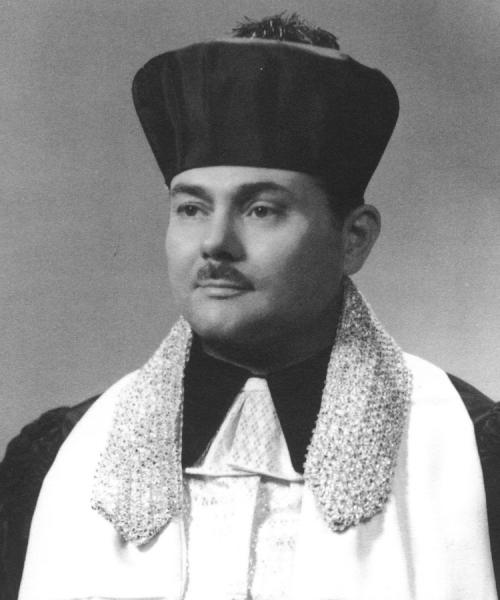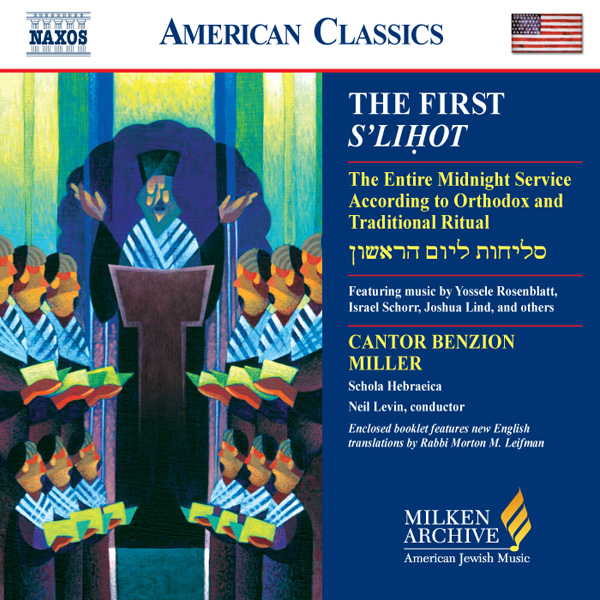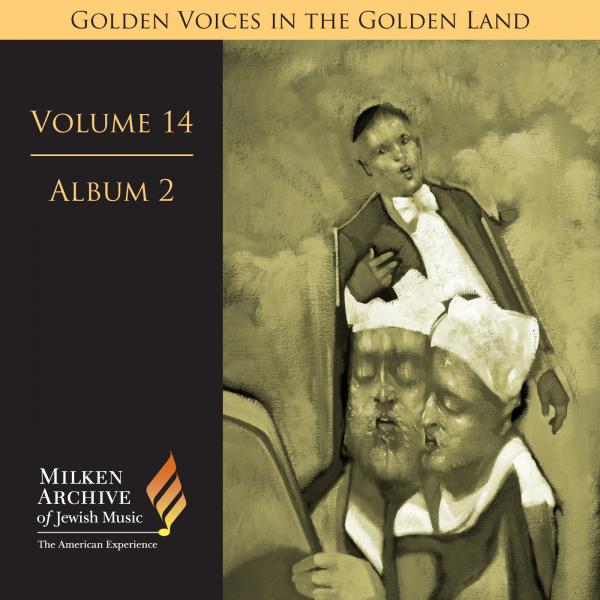
Moshe Koussevitzky possessed one of the most glorious tenor voices among the towering virtuoso hazzanim of the 20th century. He was revered by aficionados of the liturgical art and by the many worshippers whose spirits were uplifted and whose prayers were amplified through his hazzanut. He was born in Smorgon (then in Russian Poland, now Belarus, near the Lithuanian border), where his father was an amateur violinist. At the age of eight he became a chorister at the Vilna Khor Shul in the choir of the noted Hazzan Shlepak [Szlepak]. Following the commencement of hostilities in 1914 in what became the First World War, his family moved further eastward within the Russian Empire, where he studied with Hazzan Eliyahu Zaludkowsky. After the war his family relocated once again, this time to Vilna (Vilnius), where he assumed cantorial posts—first at the Zavela Synagogue and then, in 1925, at the Great Synagogue (Bes Hamedrash Hagodol).
He was the eldest of four brothers (Simcha, David, and Jacob), all of whom became world-renowned cantors—each in his own right, and each with his unique style. Both Simcha and David sang in his choirs in Vilna. In 1927–28 Moshe prevailed in highly competitive auditions for the coveted pulpit of the Tłomackie Shul in Warsaw, held until then by another of the era’s cantorial giants, Gershon Sirota. In Warsaw, Moshe furthered his studies of music and voice. Aided by the prestige of his pulpit, he soon acquired a glowing reputation throughout Europe and beyond; and in the 1930s his concert tours brought him to Vienna, Brussels, Antwerp, London, and Palestine. At a concert performance at the Tłomackie Synagogue of Haydn’s The Creation in Hebrew—part of an anniversary celebration of Hazzan Pinchas Sherman—Moshe sang the tenor role. His brother David sang the part of Gabriel, which was originally written for soprano. (Although the Tłomackie Synagogue was one of Europe’s leading liberalized but still orthodox khor shuls, female voices were considered inappropriate for a synagogue venue, even for a concert of a secular classical work.) A press review referred humorously to “the Koussevitzky disease,” by which was meant the talent of the brothers and the irresistible lure of hazzanut for them.
During the Second World War—with the help of the Polish underground and the Partisans, according to some reports—Koussevitzky was able to save himself and his family from the Germans by retreating into Soviet Russia. While there, he adopted the name Mikhail Koussevitzky and, after the German retreat, sang operatic roles in such productions as Boris Godunov, Rigoletto, and Tosca at the Tiflis National Opera Company in Georgia. Returning to Poland after the war, he performed at a concert in the presence of the British and United States ambassadors, who interceded in order to obtain visas for him for both countries. Before the war he had developed a special following in England, where his brother David had spent the war years as the cantor of the Hendon Synagogue in London and was also lecturing at Jews’ College. (All four brothers served pulpits in London at one time or another, and all were beloved there.) He thus went first to London, where the brothers reunited. The orthodox rabbinical as well as cantorial communal leadership at that time, however, still frowned, at least officially, on public cantorial concerts as religiously inappropriate and undignified for cantors as clergymen. When Yossele Rosenblatt made his first European tour as an American citizen in the early 1920s and included London on the itinerary, the cantorial fraternity in London—even more so than the rabbinical establishment—publically urged the community to stay away (although many were in the audience anyway). That attitude had not evaporated by the late 1940s and was one of the factors that induced Koussevitzky to resettle in America in 1947. (David, who by then spelled his name Kusevitsky, followed him for similar reasons in 1948.) Other considerations were the higher fees he could command in the United States and the looser rabbinical control that pertained even to orthodoxy. All four brothers sang at a farewell concert in 1946 at the Royal Albert Hall to an audience of many thousands.
Of Koussevitzky’s arrival in the United States, Benedict Stambler, the well-known cantorial record producer and chronicler of hazzanut, wrote: “His miraculous survival through the bitter war years enlisted great waves of sympathy; he was met at the pier by a tumultuous crowd and his first cantorial appearance drew throngs of emotional worshippers.”
In the United States, Koussevitzky continued to consider his sacred calling the core of his life. He occupied prominent pulpits and officiated as guest cantor for other synagogue services. At the same time, his concert performances and tours increased and brought him widespread recognition. His Carnegie Hall debut in 1947 caused a sensation, impressing the New York Times critic as “One of the outstanding voices of our time … it could hardly be overpraised.” In 1948 he toured the country with a series of recitals in which he programmed classical and operatic repertoire alongside hazzanut, with great success. In Chicago that year his Orchestra Hall recital elicited unreserved praise from the legendary but feared Chicago Tribune critic Claudia Cassidy, whom few artists pleased and whose biting (not always undeserved) condemnations could spell the instant abortion of a budding career. She confined her laudatory comments to the magnificence of his vocal equipment, his innate musicality, and his classical and operatic interpretations, wisely recusing herself from evaluating his hazzanut—a genre she had never heard, but which she found fascinating.
Koussevitzky also toured abroad to consistent acclaim, and in 1955 he reappeared at the Royal Albert Hall in London in a concert that, a decade past the turn of the century, more than a few London Jews can still recall. He also recorded prolifically—not only for Jewish concerns but for major labels such as RCA Victor.
At the time of his death, Koussevitzky was the hazzan of Temple Beth El of Borough Park, in Brooklyn—one of New York’s largest and most prestigious orthodox pulpits with a long tradition of hosting world-class hazzanim.
By: Neil W. Levin

